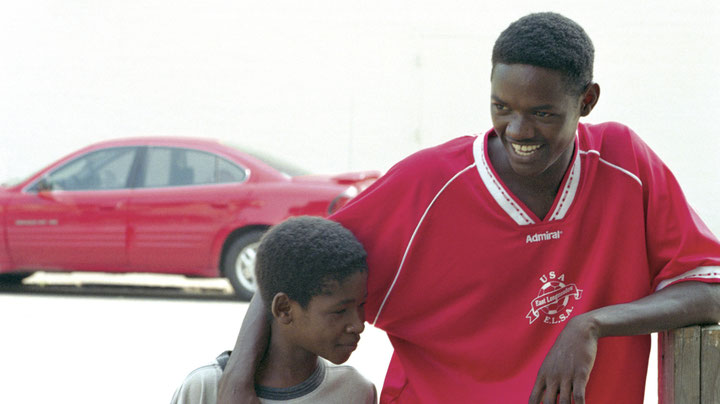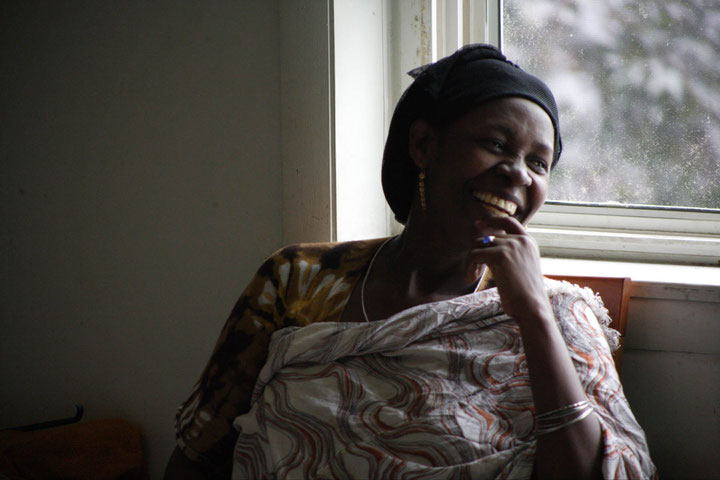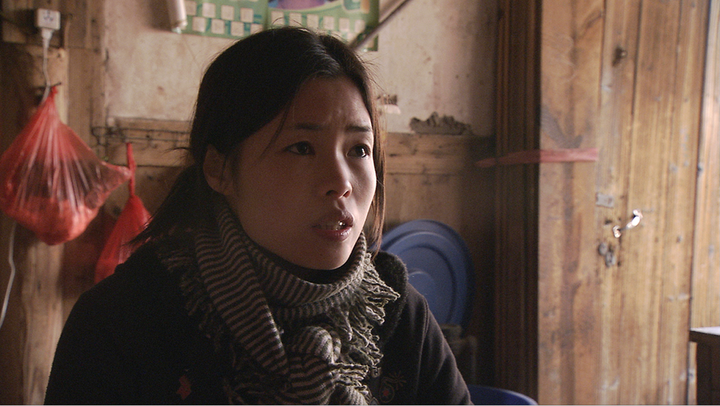Issue 2/2007 - Leben/Überleben
The survival of others
On the representation of refugees and migrants in contemporary documentary films
»The years spent making ›Rain in a Dry Land‹ were years of change – for myself just as much as for the Somali Bantu, whom I came to know so well«, notes US documentary filmmaker Anne Makepeace on her website. Descriptions of shooting films as a process involving profound transformation are not by any manner of means rare in the world of cinema. However, the transformative force contained in a long-term documentary project such as »Rain in a Dry Land« apparently entails a particularly intensive (and attractive) impact on the world view and self-perception of those involved.
»Rain in a Dry Land«, which was initiated in 2004, was completed in February 2006. The film, made by the director of successful documentaries on »Edward S. Curtis and the North American Indians« (2000) and »Robert Capa« (2005), has been invited to over 15 festivals and screened in the USA on World Refugee Day, 19th June 2007 on public broadcaster PBS. Makepeace spent more than two years with the 13 members of two extended families from the Bantu minority, originally from Somalia. The civil war forced the families to flee to neighbouring Kenya in the 1990s, where they lived in the Kakuma refugee camp until emigrating to the USA in 2004 as part of a US government resettlement programme. A new chapter of their lives began there, in two very different locations - in Springfield, Massachusetts and Atlanta, Georgia. The narrative of the 82-minute film is structured by the gradual integration of the two families into an unfamiliar social, cultural and political context, with an undercurrent of racist and anti-Islamic sentiments – stirred up by conservative media – directed against the Somali refugees and immigrants in general.
The journey accompanying the two families (single mother Arbai Barre Abdi and her children, along with a married couple, Aden Kabir Edow and Madina Ali Yunye, and their children) in the »transition from Somali refugee camp to underclass America«, as the process was described in »Variety«, 1 turned out to be a voyage that triggered changes in perception by the time it drew to a close. To quote Makepeace on her film, »the force of this film lies in the strength and beauty of the families we portray. « Strength and beauty of course seem to be inert qualities of the individuals framed by the documentary. These qualities are wrung from their harsh lives but are also part of the requisite production design if refugee existences are to function as images. In other words: strength and beauty are the bio-aesthetic material of which documentary films are made, the capital the Somali Bantu can lay on the scales to enable others (und in a certain sense themselves) to describe the course of their lives using cinematic means.
The »we« of the film team follows the progress of the two families, from the first seminars in the refugee camp aimed at preparing them for the unfamiliar reality of urban life in the USA right through to the problems and successes experienced in their new environment, with a »kind of rebirth« (Makepeace) crowning the end of the process. The resettled individuals belong to an ethnic group which has long been enslaved and subject to racial discrimination in Somalia – discrimination that still persists in Kenyan refugee camps in Kakuma and above all in Dadaab -and is heightened by a demonstrable lack of prospects even after the end of the war, which ultimately helped to bring about the USA’s resettlement initiative. 2 Against this backdrop the refugee families display a combination of »poetry, humour and astonishing assiduity and resilience« in their dealings with the film-making »we«. These contributed to ensuring that »we saw our world with new eyes«. 3
The ethical and aesthetic preconditions for films like »Rain in a Dry Land« lie in the eye-opening, transformative impact of the actions and behaviour of a group of people that the international community and its various humanitarian organisations categorise as needing protection. Refugees and others who live extremely threatened and constrained lives take on the function of witnesses to extraordinary experiences and passions. Consciously or unconsciously they become sources of heroic strategies and survival tactics.
The narrative logic taps into this potential for creativity and improvisational talent, for resistance and the will to survive, triggering reception based on identification. There is per se nothing wrong with this, given the acutely anti-immigration slant of political discussions in the locations explored, with suspicion not merely overshadowing human rights policy in the post-11th-September world but blocking out any glimmer of light. Furthermore, »Rain in a Dry Land« explicitly seeks to respect its protagonists’ individuality and to protect them from becoming mere ciphers representing a humanitarian »problem«. Rather than denying the different conflicts and coping strategies of the two families and of the individual family members, the film registers these with all the nuances stemming from the range of various psychic and social circumstances. And an empathetic observation of difficult circumstances and of how the political and economic context force the figures to find their bearings anew is certainly well served by targeted deployment of the »cinéma verité style« (Makepeace), which generates impressive and cinematographically sophisticated images. The existential panorama of emotions and personal developments is thus in a sense given a sound aesthetic footing and legitimised.
Yet however much »Rain in a Dry Land« celebrates the heroism of its figures, their grace and vitality (which also include brokenness and despair), it continues to constrain them in a role as objects of empathetic observations rather than subjects capable of taking action – also in respect of their own representation. The pleasure and satisfaction generated by discovering images of astonished faces learning about something brand new (such as post-modern life styles), or of people suffering from trauma-induced injuries bravely coming to terms with these traumata, continues to reflect the conventions of an exposition of the childishness and vulnerability »of the refugee« which tends towards voyeurism.
The victims’ innocence (in the twofold sense of guileless and guiltless) and the image of their childishness correspond to a notion of primary purity, a »tabula rasa« that permeates the visual representation of refugees in a similar manner to strategies of anonymisation or aphasi.4 Even if refugees have a chance to speak in interviews, for example in media reporting on crises, they are generally dependent on professional journalists’ or aid organisations’ media skills, and are rarely in a position to produce a depiction of their own political context. This in turn produces an image of childlike refugees at the mercy of events.5
The aesthetic of human rights is intimately linked to a conception of victims, constructed from the perspective of a subject that holds superior authority. Veristic reproduction/staging of the situation of people dependent on assistance consolidates an asymmetry between impotent and potent subjects. As Martha Rosler wrote in 1981, this asymmetry traditionally provides the structure for documentary photography (and, one might add: for documentary film).6
Furthermore, despite all the problems they have to confront, despite all the director’s efforts to differentiate in her portrayal, the fate of the two families in »Rain in a Dry Land« is destined to tell a success story, a story about how immigration succeeds, including the moving closing scenes of a meeting in Atlanta of Somali Bantu resident in the USA.
[b]Breathing life into the refugees[/b]
In contrast to this concrete utopia, which clearly subscribes to the national mythology of the USA as an immigrant county, the tragic failure of a migration project is the basic premise of the story told by British documentary filmmaker Nick Broomfield in his new film, »Ghosts«. After films like »Heidi Fleiss: Hollywood Madam« (1995), »Kurt & Courtney« (1998), »Biggie & Tupac« (2002) or »His Big White Self« (2006), in which he is inscribed more as a co-player in the biographies of his prominent and/or eccentric figures rather than being an observer, Broomfield has now shot his first feature film for many years. The screenplay is based on the Morecambe Bay catastrophe, in which 23 Chinese labour immigrants without papers died after being caught out by the high tide one night in early February 2004 while collected cockles on the sands off the coast of north-west England. In the wake of this disaster the British public gleaned shocking insights into the conditions and organisational structures in which »illegal immigrants« in the United Kingdom live – and often do not live to tell the tale. Broomfield drew on the docu-fiction genre for »Ghosts«, which had its premiere in autumn 2006 at the San Sebastian film festival. All the roles were played by non-professional actors, many of whom had been through experiences of immigration similar to those portrayed in the film. The marketing of »Ghosts« - from interviews to press releases and even the trailer - concentrates on the purported realism of the images and on Broomfield’s speculative operations on the borderline between »drama and documentary«.7
In this context an analogy is drawn between the film crew’s mobility and that of the clandestine labour migrants. This slots into the current trend towards mimetic appropriation and mimicry of the mobility (or mobilities) of migration and flight. Filmmakers such as Michael Winterbottom (»In This World« (2002), »The Road to Guantánamo« (2006)), photojournalists like James Nachtwey, Sebastião Salgado, Sarah Caron or Olivier Jobard, and reporters, for example Jason Burke or Klaus Brinkbäumer, travel along the routes taken by refugees, sticking closely to their »life experiences«. The positively rhythmic duplication of individual migration projects is the representational model that recommends conveying processes which otherwise remain abstract, static and ultimately invisible to a Western media audience through the act of sharing in the experiences of the documentary subject – at least that is the constantly reiterated justification for this cultural mimicry of mobility.
Nick Broomfield shot the apocalyptic closing scene of the fatal nocturnal high tide on location, so »realistically« that the crew and actors actually did risk their lives and a small van had to be abandoned in the sea. »Guerrilla filmmaking« (Broomfield) consequently appears to be a fitting aesthetic strategy to narrate the destinies of the migrants. Here it was important for Broomfield to steer the performance of the »non-actors« so that they appear as »themselves«. After all, Ai Qin , the leading lady, knew »how it really is« from her own experiences, i.e. what »happens« on a difficult journey, shaped by humiliation and exploitation, from China to the slave-like employment conditions in England. As Broomfield puts it, Ai Qin’s »story«, which she, like the other actors, contributed to writing within the framework of the established screenplay, deals with the »fight for survival« and yet is at the same time a »story of hope«.8 »The emotional essence of migration is being separated from your loved ones«, as Broomfield put it in an interview with the »International Herald Tribune«. But most people »don’t care about immigration as a human issue as they never needed to.« That means it’s up to cinema to overcome this indifference. »Migration is boring«, says Broomfield, »which is why you have to make the issue come alive.«9
Nick Broomfield’s theory of the »life« that cinema could breath into the phenomena of »flight« and »migration« complements Anne Makepeace’s statements about the way in which film-making makes her feel »alive« more than anything else does10. Discourses on life and vitality, on the authenticity of the »live« and non-professional performances and the varying degrees of »vividness« in fiction, docu-fiction and documentary modi continue to frame (and indeed play an increasingly role in) cinematic perception and portrayals of the ways of life experienced by refugees and migrants. The protagonists of this life are scarcely present as political subjects in this process, and are equally absent as subjects of representations. One gains the impressions that this is also (and even particularly) the case when filmmakers strive above all to render visible their protagonists’ struggle for survival. The understanding of politics informing this approach may well incorporate aspects such as employing immigrants who need a job, for example when Broomfield offers actors temporary and »legal« employment through his film.11 In addition, films like »Ghosts« or »Rain in a Dry Land« in many ways react to political discussions on immigration and humanitarian commitment. Alongside dystopian scenarios of despair, they also dish up images and narratives of the kind of »good practice« and »positive contributions« that refugees (should) manage to demonstrate in host countries and their social communities in order to counteract widespread»negative perceptions«. The United Nations High Commissioner for Refugees (UNHCR), partly by funding research, has for some time now been engaged in efforts to bring about this kind of change of course, moving away from »reactive« responses to refugee crises and towards »pro-active« measures to »secure livelihoods«, putting into practice what has been dubbed the livelihood concept.12 »Livelihood« is the codeword of a new focus on private households’ survival strategies and how these contribute to national or regional economies. The emphasis here is primarily on organising a durable and ultimately non-nomadic economic and legal existence.
Irrespective of their partial success, when one considers films such as »Rain in a Dry Land« or »Ghosts« and how they are embedded in discourse, it is impossible to overlook the fact that the subjects of »bare life« above all embody the scant resource of vitality, moving towards a sustainable livelihood in the best case scenario. Self-determination and agency have indeed long been consensual terms in negotiations on regimes governing humanitarian responses to refugees and migrants. Yet the political comprehension of agency established in the 1990s is increasingly giving way to a conception whereby successful survival can produce a specific human resource of economic interest – possessing both aesthetic and economic value.
This appears to correspond to the idea that some ominous power, ultimately amounting to the governamentality of global mobilities – in realms too where one must at least suspect the enlightened gaze of »political« documentary film makers must be present – apparently ensures the blind spots are multiplied systematically. Thus the call for agency and the desire for life and vitality overlap in a typical discourse figure of current bio-political relations. Modulating and deconstructing this figure could be the task facing aesthetic political practices, which do not confuse life, survival and livelihood with agency, or reduce agency to political actions.
Translated by Helen Ferguson
1 John Anderson, Rain in a Dry Land, in: Variety, 8th March 2006, http://www.variety.com/index.asp?layout=print_review&reviewid=VE1117929899&categoryid=31
2 Cf. e.g. Cindy Horst, Transnational Nomads. How Somalis Cope with Refugee Life in the Dadaab Camps of Kenya, Oxford/New York 2006.
3 All quotes from the website of filmmaker Anne Makepeace (makepeace productions), http://www.makepeaceproductions.com/rain-in-a-dry-land.html
4 Cf. Liisa H. Malkki, Purity and Exile: Violence, Memory and National Cosmology among Hutu Refugees in Tanzania, Chicago/London 1995, p. 11; Reiko Shindo, Imagined Refugees: Representation of Refugees in Photographs, Forced Migration Student Conference 2006, pp. 8 ff.
5 Cf. e.g. Terence Wright, Collateral Coverage: Media Images of Afghan Refugees, 2001, in: Visual Studies, Vol. 19, No. 1, 2004, pp. 97–111, here 105f.
6 Martha Rosler, Drinnen, Drumherum und nachträgliche Gedanken (zur Dokumentarfotografie) [1981], in: ibid, Positionen in der Lebenswelt, ed. Sabine Breitwieser in conjunction with Catherine de Zegher, Vienna/Cologne 1999, pp. 105–148, here p. 109.
7 Nick Broomfield, quoted from.: Modern Slaves Without a Ghost of a Chance, in: Guardian Unlimited: Arts blog – film, 10th January 2007, http://blogs.guardian.co.uk/film/2007/01/modern_slaves_without_a_ghost.html [Status February 2007]
8 Cf. websites on Ghosts, http://www.ghoststhemovie.co.uk/ and http://nickbroomfield.com/Ghosts/press/index.html [status February 2007]
9 »Immigration is boring, so you have to give it life« (quoted from.: Geoff Pingree, A Lens on Immigration and Its Impact, in: The International Herald Tribune, 3rd October 2006).
10 »When I’m making movies, I feel the most alive. It challenges me, and inspires me« (Life Portrait [Interview with Anne Makepeace by Chrystal Ann Sturtevant, on the occasion of the film Robert Capa: In Love and War], New England Film, May 2003, http://www.newenglandfilm.com/news/archives/03may/makepeace.htm [Status February 2007]).
11 Geoff Pingree argued along these lines in the International Herald Tribune [cf. note 9].
12 Cf. by way of a recent overview: Cindy Horst, Introduction: Refugee Livelihoods. Continuity and Transformations, in: Refugee Survey Quarterly, Vol. 25, No. 2, 2006 [Focus on »Refugee Livelihoods«], pp. 6–22.


